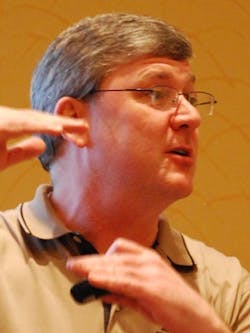About the Author
Nancy Bartels is managing editor for Control magazine. Email her at [email protected] or check out her Google+ profile.Want to get the attention of a big group of process automation professionals? Offer a discussion about the problem of alarm management — not surprising when you consider that alarm management related issues cost more than $20 billion per year in United States alone. Proof of the commonality of alarm management concerns came this afternoon when Nicholas Sands, manufacturing technology fellow at DuPont, told of the company's "Global Alarm Management Story" to a standing-room-only audience at the Honeywell Users Group Americas conference in Phoenix, Ariz., Before he began, Sands provided some context for the knotty problem of alarm management. Basically, most control room operators have too many alarms, most of which are extraneous. There are stale alarms, chattering alarms, alarms that do not require a response and other nuisance alarms. Ideally, said Sands, there should be one screen that only comes on when an operator really, really has to take an action immediately. To begin the path to correcting some of these problems at DuPont, its teams developed some rigorous goals."Acknowledging the alarm is not a response," says Sands. "We need to get to point where only alarms that require operator action are communicated to the operator."To get to that point, he said, it must be realized that the function of an alarm should be to give the operator an indication of the right time to take the right action to avoid undesired consequences. Then alarms should help the operator keep process performance within limits. Nuisance alarms should be identified and corrected. And, finally, he adds, "You can't do alarm management without monitoring."A Nine-Step ProgramSands and the DuPont team developed a nine-step program to achieve its goals, which would require a culture change in the way alarms were handled at DuPont. Number one was getting leadership. First you need a sponsor high up in the organization. In DuPont's case, it was the head of operations for the entire company "You make driving the program one of his key responsibilities. It has to be a priority," said Sands.
"We've had a dramatic reduction in nuisance alarms." DuPont's Nick Sands on the company's global roll-out of Honeywell's Alarm Manager software.Next comes monitoring. You need to gather data over time and analyze it before you do anything else. Speak with the operators. Find out what they think about the current alarm system. Then you benchmark where you are. Next, go for the quick hits and the easy fixes. Sands told of eliminating 10,000 alarms a month easily when the team discovered that at one DuPont facility every alarm was being duplicated in both English and Spanish. These kinds of fixes make for a lot of improvement easily and make people believers. Then train your people. In DuPont's case that meant computer-based training for 15,000 operators in 14 languages. After your people have been trained on the system is the time to develop an alarm philosophy for your operation. The last three steps are rationalization of all your alarms — an ongoing process which presently engages some 4,000 people across DuPont — continuous improvement and a regular audit. This audit feeds back to management regular reports of the improvements shown and continues to drive the change and improvement. With the help of Honeywell, DuPont rolled out in 2012 a companywide alarm monitoring system that archives and analyzes alarm activity in one central database. Now over 250 control systems worldwide are monitored regularly. Users can access the alarm management tools from thin clients across the world. "We've had a dramatic reduction in nuisance alarms," said Sands. "We've made progress in overall alarm system performance. Our goal is to reduce alarms even more."In terms of hard numbers, Sands says the implementation of a single global instance of Honeywell's Alarm Manager saved DuPont $5.5 million in infrastructure costs, $7 million in technical support and approximately $1 million in server support costs compared with a traditional, site-specific roll-out."Honeywell's Alarm Manager has supported a culture change around alarm systems and alarm management at DuPont," Sands said. "Team work with Honeywell alarm management specialists was critical to our success. The alarm data has been enlightening, revealing where improvements can be made. Alarm Manager is a new but important part of DuPont's process safety management program."
About the Author
Nancy Bartels
Nancy Bartels
Sign up for our eNewsletters
Get the latest news and updates

Leaders relevant to this article:



